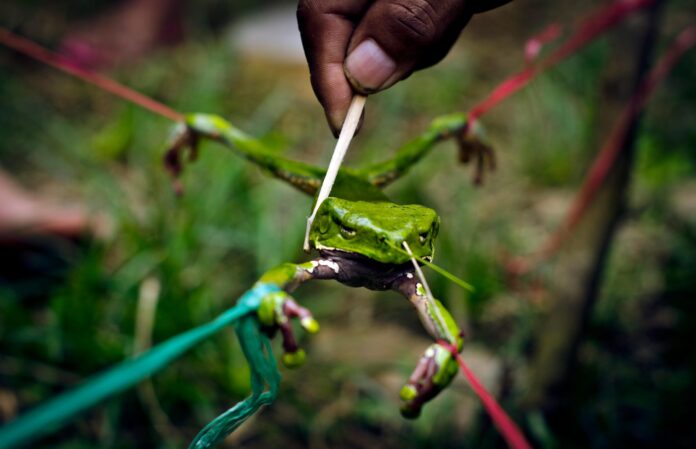ADVISORY WARNING: Kambo is a controversial medicine in the psychedelic community because the process of collecting the secretion can potentially be harmful to the giant monkey frog, or in some cases highly stressful. Proponents of kambo often claim to collect the medicine respectfully and gently; however, there is little regulation that exists in this area, and few assurances of the frog’s quality of treatment. Individuals who feel called to experience kambo are urged to research their sources and facilitators with great caution and to consider the implications carefully in terms of animal rights and sustainability.
What is kambo?
Kambo, also known as sapo or “frog medicine,” is not a psychedelic substance in the technical sense, but it is an indigenous Amazonian medicine that is often grouped alongside traditional psychedelic plant medicines (such as ayahuasca and huachuma). Kambo is a secretion from a poisonous giant monkey frog (Phyllomedusa bicolor), native to South America.
What is the kambo experience like?
When the giant monkey frog is distressed or senses danger, it releases a secretion. The secretion can be gathered by scraping it off the skin of the frog’s back, in a process that is controversial within the plant medicine community. The kambo practitioner then uses a burning stick to make small burns on the participant’s body, usually on the arm or shoulder. Once the burn has blistered, the blister is scraped off, and the kambo is applied to the wound. Once applied, the secretion produces strong physical purging, which lasts from 5-30 minutes, on average. Following a kambo purge, participants often feel an intense sensation of physical and psychological wellbeing. Within indigenous traditions, kambo is typically used for detoxification.
Brief history of kambo
Traditionally, kambo has been used as a purgative and stimulant. Research shows that the medicine was often consumed in tribal cultures to cleanse and stimulate the body in preparation for hunting. In recent decades, kambo has become popular among Westerners for its detoxification properties.
Kambo Safety
Kambo is traditionally used as a purgative and a detoxifier, not a psychedelic, although it is commonly grouped with psychedelic plant medicines. In addition to questions of animal rights and sustainability, kambo carries some significant safety risks to users. In recent years, some injuries and deaths have been reported in association with kambo. Kambo should not be used by those with the following health conditions:
— Cardiovascular conditions— Hypotensive syndromes (e.g. Shy-Drager syndrome)— History of mental disorders, including psychosis, severe anxiety disorders, severe depression, and/or bipolar disorder.
— Women who are pregnant or breastfeeding.
Many retreat centers and organizations currently offer kambo in combination with other substances, although this is not the way that the medicine has traditionally been used. From a safety perspective, kambo should not be combined with other psychedelic medicines (including ayahuasca, iboga, huachuma, bufo, or salvia), as the pharmacological risks and interactions between these medicines is not well researched or understood.
Part of a kambo ceremony includes a large intake of fluid, including cassava tea and water. Users should be careful not to drink excessive amounts of fluid, as there have been multiple case reports of people developing SIADH, as well as cerebral edema (brain swelling) and other complications related to excessive fluid retention. It is recommended not to consume more than 1.5-2 liters of fluid in total before, during, and following a kambo ceremony.
Kambo Science
Pharmacology
The active components in kambo are powerful polypeptides. The polypeptides are bioactive and highly concentrated in the secretion of the Phyllomedusae frog. When applied to human skin, the polypeptides produce an intense effect on the body, leading to a range of clinical effects. The effects on the muscles and circulation system lead to flushing, hypotension, vomiting, nausea, angioedema and secretion of bile.
According to current research, there are several peptides that are directly responsible for the body’s response to kambo, including phyllomedusin, caerulein, sauvagine and phyllokinin. The feelings of wellbeing, euphoria and alertness that follow a kambo session may traditionally have supported stamina for hunting among indigenous people groups. Studies also indicate that the peptides caerulein, deltorphine, and dermorphine also convey analgesic properties and interact with the body’s opiate receptor system.


